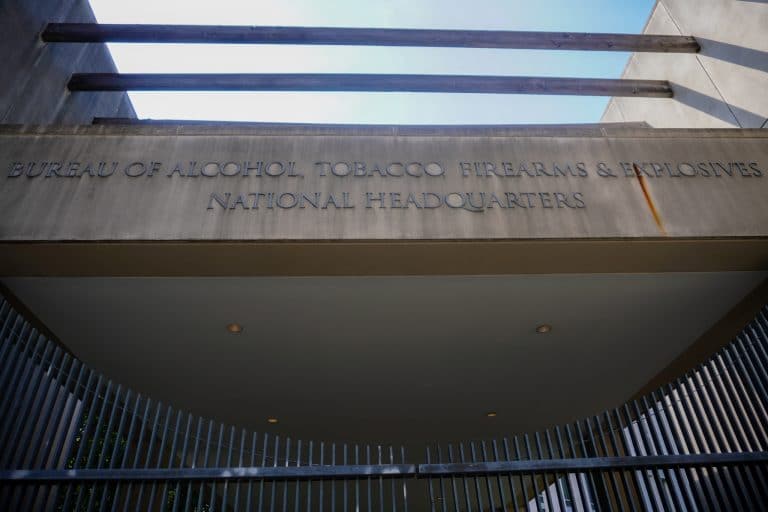The Trump Administration just released new budget documents that, if adopted, stand to dramatically shift how guns are regulated. There are a lot of hurdles to clear before the proposal can become law, though.
The Justice Department released its Fiscal Year 2026 budget request late last week. The sprawling 258-page document outlines how the department proposes complying with President Trump’s May discretionary budget request and its directive to slash non-defense discretionary spending and revamp federal agency priorities.
Here’s a look at some of the key details from the DOJ’s budget summary and what they might mean for gun owners.
Slashed ATF Budget
A reduction in funding for the Bureau of Alcohol, Tobacco, and Firearms (ATF) was already telegraphed by the President in his initial budget request last month.
“The Budget bolsters the Second Amendment by cutting funding for ATF offices that have criminalized law-abiding gun ownership through regulatory fiat,” the White House wrote in a summary document calling for a $468 million reduction in the agency’s budget.
The DOJ’s report appears to make good on that request and fleshes out how it will accomplish that goal. It calls for a 25.7 percent reduction in the agency’s budget compared to Fiscal Year 2025, resulting in a total budget of just over $1.2 billion. In doing so, it proposes eliminating 1,465 positions at the agency, the bulk of which will come from the inspectors currently tasked with oversight of the firearms industry. The reduction would impact roughly two-thirds of inspectors currently tasked with regulating federally licensed gun retailers and manufacturers.
“ATF will eliminate 541 Industry Operations Investigators (IOIs), reducing ATF’s capacity to regulate the firearms and explosives industries by approximately 40 percent in FY 2026,” the document reads. “ATF will perform fewer regulatory inspections of Federal firearms and explosives.”
Elsewhere, the department anticipates eliminating another 470 full-time agents and support personnel through standard attrition. It also plans to end current programs aimed at digitizing its crime gun tracing efforts as well as instituting a freeze on new vehicle purchases and personnel relocations to further reduce costs. The plan would also cut plans to further streamline ATF’s eForms processes, an effort that has already resulted in a massive decline in wait times for things like National Firearms Act registrations.
Proposed ATF Merger
Confirming a shift rumored to have been under discussion since at least March, the DOJ’s budget report also proposes terminating the ATF’s status as a standalone law enforcement agency, reducing its scope of work, and housing what remains under the auspices of the Drug Enforcement Administration.
“ATF is eliminated as a separate component, with its functions merged into the Drug Enforcement Administration (DEA),” the budget proposal reads. “After absorbing select functions of ATF, DEA will remain as a single component that will address violent crime, drug enforcement, and crimes relating to firearms.”
The justice department argued that pursuing the merger will lead to “efficiencies in resources, case deconfliction, regulatory efforts, and reductions of duplicative functions and infrastructure.”
Once consolidated, DOJ would take the departments with addressing both drug and gun crimes as they pursue “the fight to eradicate the designated cartel foreign terrorist organizations (FTOs) and seek to eliminate violent crime.”
Funding for Rights Restoration
Outside of proposed overhauls at the ATF, one area of the DOJ’s budget request that could impact gun policy actually comes in the form of a small funding hike.
The request calls for an additional $488,000 for the Office of the Pardon Attorney to “lead[] the Department’s initiative on creating and establishing a process for restoring firearm rights to citizens.”
While still relatively light on details, the request offers new insight into how the administration hopes to handle the recently revived firearm rights restoration process on more of an ongoing basis. Notably, the plan won’t fund even a single new position to oversee the process.
“This funding will allow PARDON to support development of an IT case management system to implement an application intake, review, and management process for citizens applying for the restoration of firearms rights,” the request reads. “The Department is committed to establishing a process to review and evaluate these claims at minimal cost. Working in conjunction with the Criminal Justice Information Services Team at the Federal Bureau of Investigation, the Office of the Pardon Attorney is developing an easy-to-use web portal for the acceptance of applications. The new process will leverage technological advancements and system integrations to maximize efficiencies and minimize the manual review of applications for restoration.”
Remaining Considerations
A significant caveat hangs over the administration’s budget proposal: while the President’s thoughts on federal spending certainly carry weight, they remain only that—a proposal.
Under Article I of the Constitution, Congress has the power of the purse. As such, the contours of what ultimately becomes the Fiscal Year 2026 budget will almost entirely depend on the political considerations of 535 lawmakers rather than one chief executive. As recent political history has demonstrated, appropriation bills that have made it into law have tended to differ significantly from the presidential budget proposals that preceded them.
Couple that with the politically fraught nature of something like merging the ATF and DEA, for instance, which has already drawn opposition not only from gun-control advocates and ATF leadership but also from gun-rights groups as well as the firearms industry itself, and it’s easy to imagine Congress leaving some of the administration’s more ambitious gun-policy-funding proposals on the cutting room floor.
At the same time, the President’s party currently controls both the House and the Senate. And, though their majorities are slim, thus far, Republican lawmakers have shown a tremendous amount of deference to the President, even when that has been politically challenging. Perhaps that pattern will hold during budget negotiations.
The funding for rights restoration, on the other hand, may ultimately prove to be less politically controversial and could easily become law regardless of the President’s sway over Congress. But it also stands to potentially be the least consequential. At just $488,000, with no actual staff dedicated to the project and a still-to-be-determined semi-automated application procedure, it’s unclear how effective this new rights restoration process will be. By comparison, the year before Congress defunded the original rights restoration process under ATF in 1991, the effort had a budget of over $4.2 million and employed 46 full-time staffers to process requests. That was 34 years ago.
While it’s certainly not out of the question that modern technology makes that kind of funding unnecessary in our current era, that still represents a 95 percent reduction in funding in real terms since the last time the federal government actively worked to restore the rights of previously disarmed Americans. Meanwhile, the number of possible applicants to such a process has grown to more than 25 million convicted felons, to say nothing of the millions of others who may fall under the other disqualifying criteria.
Of course, that concern, like much of the rest of the budget request, will have an opportunity to be addressed during the lawmaking process.






